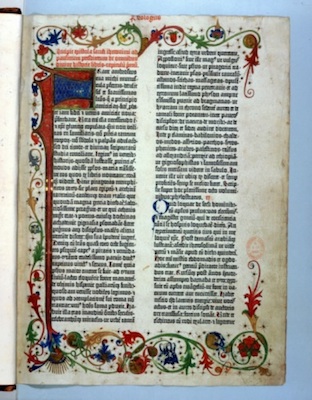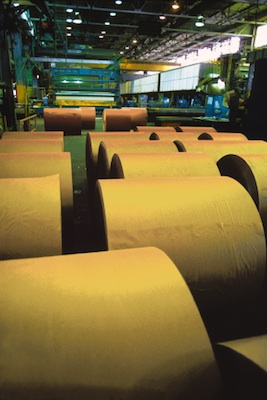Paper is made from plants.
The plants are soaked till they are mushy.
The mush is put in a tub of water.
A screen scoops up a layer of the mush.
When the layer is dried, it is ready to write on.
Papyrus is a tall wetlands grass. ©Getty Images
History of paper
The word 'paper' comes from papyrus (say pup-eye-russ), a tall wetlands grass. In Ancient Egypt over 5,000 years ago, people cut strips of papyrus, and soaked them in the river to soften them. The strips were then laid out in a criss cross pattern like a mat, then rolled and pressed into a thin sheet before being dried in the sun. The dry, light sheets were used to write on by the Egyptians, Greeks and Romans. Similar paper-like products were made in other countries such as South America.
The Ancient Egyptians made papyrus over 5000 years ago. They wrote and painted onto it. © Getty Images
Ancient Chinese paper, from around 700 AD ©Getty Images
The first true paper was made in ancient China in 105 AD,
The first true paper was made in ancient China in 105 AD when a member of the Emperor's court, T'sai Lun, worked out a way to make paper. Plants believed to be mulberry bark and hemp (used for rope making), and rags were soaked until the fibres separated. These fibres were then put into a large vat of water and a screen was placed in the water and lifted up carrying a thin layer of connected fibres. This was then dried, and became a thin, strong, smooth paper that could be rolled or folded.
For centuries China kept this way of making paper a secret. But in the 3rd century it began to be revealed, first to Vietnam and Tibet, and later Korea, and in the 6th century, Japan. From Nepal then through Asia and India the art of papermaking spread through the Middle East to places like Baghdad, Damascus and Cairo.
Did you know that the the first paper money was used in China in the 800s?
A page from Gutenberg's Bible. © Getty Images
In Europe, the use of papyrus died out in the 9th century, and artists and writers used parchment, which was made from animal skin. However, it was very expensive, so written or artistic works were precious and quite rare. When the Moors from North Africa invaded Spain and Portugal in the 12th century, they took the method of paper making with them, and gradually the idea of paper being an everyday item took hold.
In 1456, Johann Gutenberg invented a printing press that used movable type. He printed the Bible onto paper, and it is recognised that the printing industry began from this. The demand for paper grew, and this meant greater production was required. The method of making single sheets of paper one at a time no longer produced enough paper to meet the demand. Late in the 18th century, Nicholas Luis Robert invented a machine that could produce a long length of paper without joins on a wire mesh with rollers at one end to squeeze the moisture out.
An old style printing press © iStock
This machine was improved further, and the mass production of paper soon became a huge industry.
Huge rolls of paper in a modern factory. ©Getty Images
Some properties of paper
Paper can be strong. (packaging)
It is flexible. (for wrapping things, making origami)
It is absorbent. (paper towel)
Watch a video about making paper at a modern factory using sustainable timber.
Recycling paper
It is easy to make new paper and cardboard out of recycled paper. It saves energy and water because it takes less of both to make recycled paper. Recycling also means that less paper ends up in landfill.
Artisan papermaking
Artists are once again making paper by hand, one sheet at a time. ©Getty Images
The art of making paper by hand almost died out, but in Japan it remained a highly respected art form. Japanese so-called 'rice paper' is actually made from the fibres of the mulberry tree, not rice. In Thailand, handmade paper used the pulp of khoi trees, but early in the 20th century this declined because the trees were almost gone. During the second World War, the Japanese occupied Thailand for a while, and introduced Thai paper makers to the use of mulberry trees which grow abundantly in Thailand, known as 'sa'. This revived the art in Thailand, where it flourishes today. In many countries now there are artists who make their own paper by hand. It is called artisan papermaking.
Try making your own paper from recycled paper.
Some other facts about paper
Paper tissues have replaced handkerchiefs made of cloth ©iStock
Teabags are made of paper, but when they were first available in 1903, they were made from silk.
Paper tissues have been around since the 1920s.
The first paper making machine was invented in 1798.









